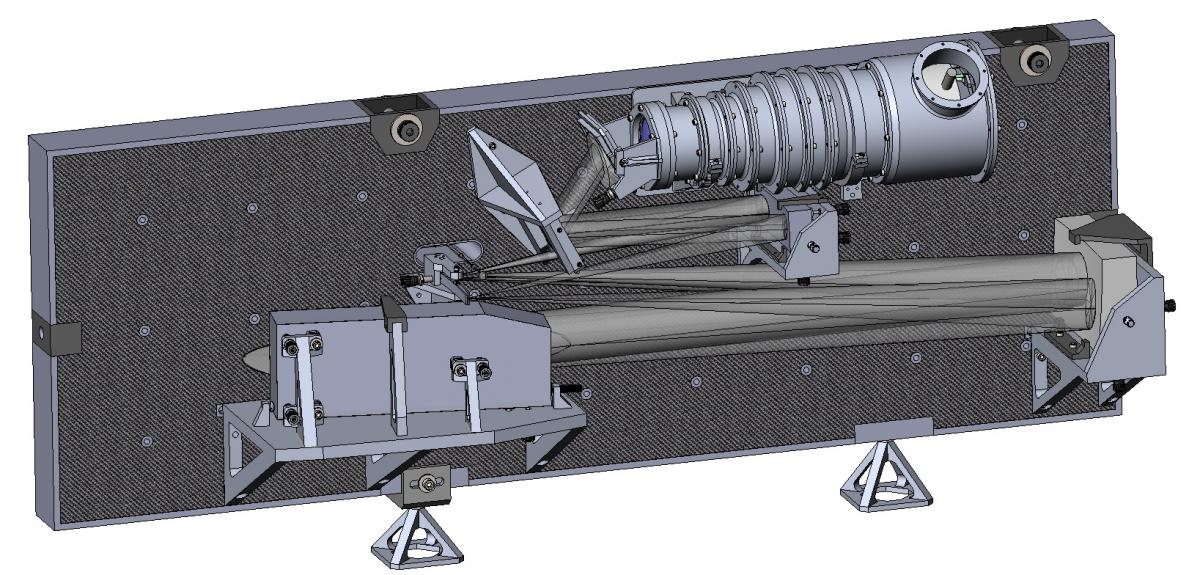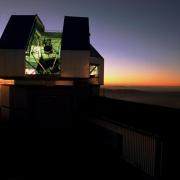Summary Our Role Gallery Links
Our group developed the WIYN Spectrgraph for DOppler Monitoring (WISDOM) concept from the ground up, in response to NASA’s call for an extreme precision Doppler spectrograph. Such an instrument takes very high resolution spectra of stars that are suspected to host planets. If periodic back-and-forth displacement is observed in the spectral lines that can prove the existence of an exoplanet, and what’s even more measure its mass. These type of instruments are standard tools to search for exoplanets, or confirm/study those discovered by efficient survey missions like Kepler and TESS.
The WISDOM optical bench design with one of the cameras shown.
For this instrument proposal we came up with the science case and the basic instrument architecture. Once selected and awarded by NASA we spent 6 months to develop conceptual level details of the spectrograph and related components: the fiber link connecting it to the telescope, the telescope interface, a calibration system, proposed a data reduction and a control system. For the detailed design and architecture of these subsystems see the links below:
Science Case: One of the most surprising and important findings in astronomy today is that nearly half of Sun-like stars have at least one planet with an orbital period shorter than one year, and a size in between that of Earth and Neptune. But finding and characterizing these new worlds requires unprecedented measurement precision careful determination of instrument design. We put together a logical flow-down of how the big science questions translate into instrument design parameters.
Spectrograph: Sound or light emitted from moving objects gets distorted, we all experience it when approaching vehicles make a higher pitch noise. For light the distortion is far less obvious, think of a 20 megapixel high resolution digital camera/cellphone image shifted by 1/10,000th of a single pixel. That only can be detected if your ‘camera’ is extremely stable, otherwise small shifts (vibrations, thermal expansion, etc.) in your spectrograph can mimic/hide the real changes in the recorded spectrum. In our design we aimed to remove and/or suppress all sources of measurement noise, to allow for observations of Earth-like planets.
Fiber Link: Telescopes are exposed to changing environment (temperature, wind) and need to compensate for the apparent motion of the sky. This makes it very hard to attach a spectrograph to them directly while maintaining the extreme stability required, as described above. So we rather place the spectrograph in a well controlled room, some distance away from the telescope. But then we need to deliver light collected by the telescope to the spectrograph, without loosing any of it as astronomical objects are faint and every photon is precious. These fiber optic links are much more demanding than your typical internet connections!
Telescope Interface: While there are lot of stars visible to the naked eye, many interesting objects are too faint to be seen - unless we collect many-many photons by a light bucket. The larger the telescope the better it is, and more expensive they become to build an operate. So we need to share a telescope between many different instruments and science programs, and thus develop careful interface/integration to our own instrument into a higher level observatory environment.
Calibration System: A measurement is comparing something to a known entity, a reference that always and for everyone means the same. Detecting shifts of spectral lines in a spectrum is no different. We need to establish wavelength markers that are more stable than the change in the position of the spectral lines themselves. There are multiple way of ding this, and the state of the art uses very unique lasers, called frequency combs, that are linked to not less exotic sounding atomic clocks.
Control System: A modern astronomical instrument has several moving components, cameras, and other sensors. Not to mention it all has to be able to communicate with the telescope and the overall observatory. For Doppler spectrographs, due to the extreme stability requirement, there are dozens and dozens of sensors that constantly monitor the instrument environment, too. A control system that allows orchestrated operation of all these components can be quite complicated.
Data Reduction: During a typical night observing of Doppler spectroscopy hundreds of of high resolution digital images are taken, totaling to about 10-20GB of data. Once it has been all processed, however, shrinks down to a few dozen numbers of as-measured line-of-sight velocity of exoplanet host stars/candidates. But given the extreme precision required and the many potential noise sources an artifacts this data reduction is very, very complex.



